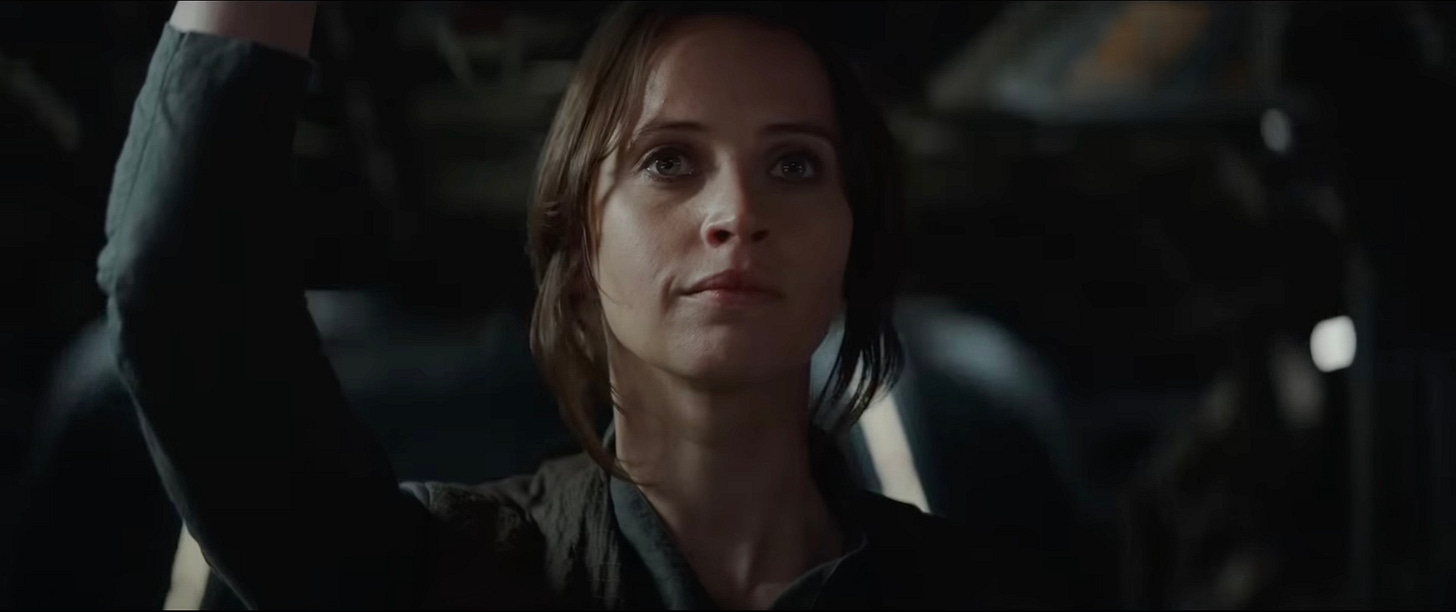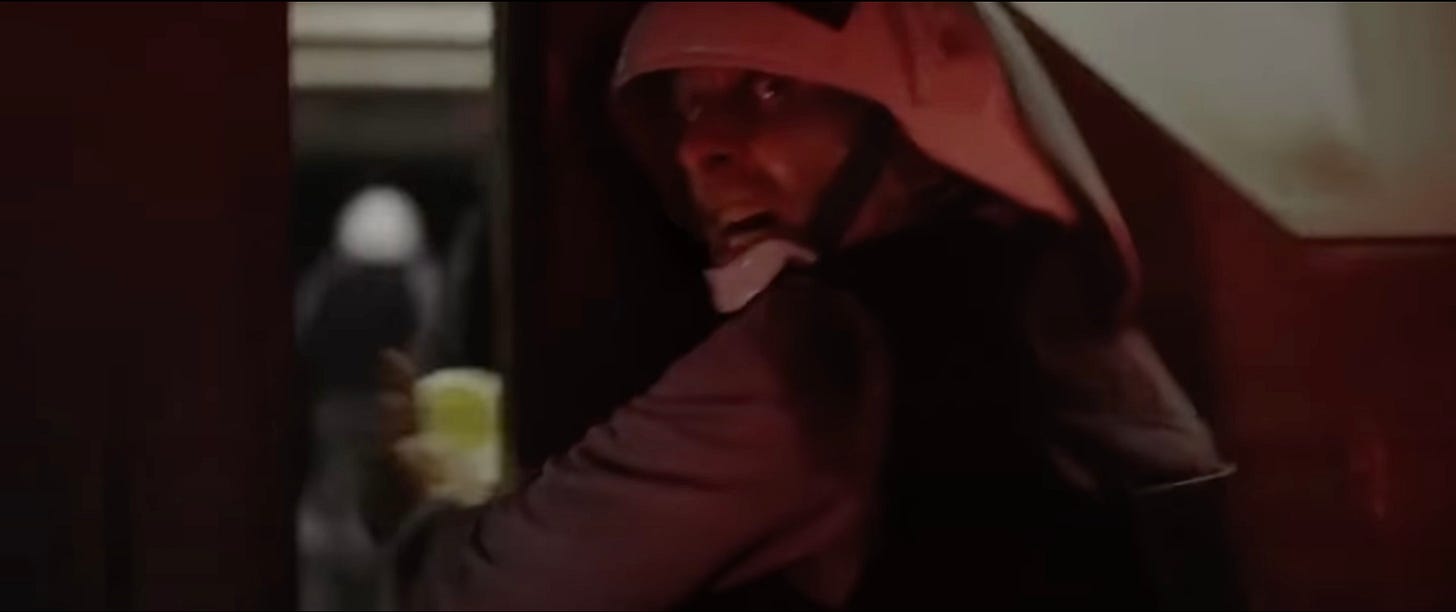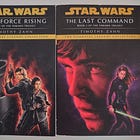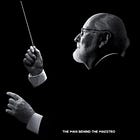Welcome to And the Quest for Pop Culture, where I explore various movies, TV shows, books, and comics. Looking for a different topic or original fiction? Check out the navigation page.
Star Wars Episodes 1-3 were not the prequels I was looking for.
Rogue One: A Star Wars Story, however, was the prequel I didn’t know I needed. It’s the best Star Wars movie outside of the original trilogy.
In the first movie, Luke Skywalker joins a rebellion already in progress. While he was playing with power convertors on Tatooine, rebels were giving their lives to oppose the Empire. The action was underway; it was not waiting for him. That was the point—the boy yearned to leave the comforts of home and make a difference in the wider galaxy, where he could become a man. Until he did that, he was missing out on important events.
“It is a period of civil war. Rebel spaceships, striking from a hidden base, have won their first victory against the evil Galactic Empire,” declares the opening crawl of the 1977 movie, the first bit of information audiences received about the galaxy far, far away.
“During the battle, rebel spies managed to steal secret plans to the Empire’s ultimate weapon, the DEATH STAR, an armored space station with enough power to destroy an entire planet.”
There’s a story in that third sentence, but that story is not essential to this movie. All we need to know is that Leia has received intel about the Death Star’s secret weakness and has placed this information in R2-D2. This intel allows Luke to score a key victory during the climax, but how the information was obtained has nothing to do with him.
We also don’t need to know how this fatal flaw slipped by the Empire’s engineers in the first place. Hubris suffices as a perfectly natural explanation.
Nevertheless, this backstory contained ample potential for a worthwhile spin-off story, and nearly four decades later, that story finally came to life. By and large, director Gareth Edwards and his team got it right. The screenwriters (Chris Weitz and Tony Gilroy) and story developers (John Knoll and Gary Whitta) built a strong emotional core into what easily could have turned into a plot-heavy amusement park ride.
SPOILERS ahead!
Obviously, the Death Star didn’t build itself, nor did it invent itself. Emperor Palpatine didn’t smote a moon with his Force lightning and out sprang the planet-killing space station. People made the Death Star. In Rogue One, one of these people becomes a character: Galen Erso (Mads Mikkelsen).
Military director Orson Krennic (Ben Mendelsohn) forces Galen to work on completing the Death Star, and the Imperials murder his wife right in front of him. Galen complies, in part to help protect his daughter but also because he’s realized the project is far enough along to reach completion with or without him. If he’s participating in the work, he’ll have an opportunity to build a key weakness into the design. Galen helps Krennic while slipping in revenge and resistance. See, if you bully people into working for you, you don’t exactly get the best results.
But Galen is not our main character. The movie focuses on his daughter, Jyn Erso (Felicity Jones). Fifteen years have passed since her mother’s death and father’s capture, and she’s basically been a criminal with no real purpose to strive for. The Rebel Alliance presses her into service once they learn about the Death Star’s existence. A holographic recording of her father—plus a tragically brief reunion with the man himself—inspires her to join the cause.
The recording is destroyed after Jyn sees it, and she’s its only living witness. When she tells others that the Death Star has a weakness, they need to decide whether or not to trust her. They have no proof that the schematics actually would reveal a fatal flaw, no proof that retrieving this information would be worth the tremendous struggle and risk. Not everyone is willing to take this leap of faith.
Limiting the evidence to Jyn’s own mind is an inspired touch, and it reduces any sense of inevitability. We know what ultimately happens to the Death Star, but the characters don’t. Throughout the movie, the writers ensure that everything is hard and nothing is a given; they show how the Rebellion could have collapsed entirely if not for the perseverance of a relatively small team.
Leading that team is Cassian Andor (Diego Luna), a rebel who’s had to get his hands dirty for the cause. But his conscience demands that these questionable deeds serve a greater purpose. He trusts Jyn because he needs the hope her mission provides.
The team must endure a gauntlet at an Imperial base to obtain the Death Star schematics and transmit them to the rebel fleet. Strenuous effort persists throughout. Small actions build upon each other—flip this switch, plug in that cord, adjust the antenna, push those buttons—but all the pieces are spread out, requiring different rebels to each do their part, all while getting shot at. It’s one near miss after another. There’s no way everyone is getting out alive; they just need to survive long enough to do their part.
Toward the end of this gauntlet, Jyn comes face to face with Krennic, the man who destroyed her family and represents all that’s evil in the Empire. For Jyn, the Empire is no abstract, academic matter. Her objections do not stem from navel-gazing pontification. No, the Galactic Empire has caused her direct pain and suffering, and it’s about to inflict a whole lot more if she doesn’t come through.
Even after she succeeds, the rebels very nearly lose the information. Darth Vader cuts through the rebels, unleashing the full fury of the dark side against them. It’s the most physical and the deadliest we’ve ever seen Vader—filmmaking technology has finally caught up with his power.
While that’s satisfying for longtime fans to watch, the actions of the rebels are far more meaningful. Dying rebels pass the disk from one man to the next, handing it over just in time, prioritizing this disk over their own lives, trusting that it will save others.
We don’t know their names or anything specific about them, but they, too, play a pivotal role in bringing about the victory achieved in Star Wars: A New Hope. It’s the ultimate relay race, one whose failure would negate many sacrifices.
Among those sacrifices is Jyn herself. The hero succeeds, but she doesn’t survive. She was never getting off that planet. The Empire is so desperate to protect itself and cling to power that they aim the Death Star at the planet and wipe out the entire city. Krennic, fittingly, also dies here, hoisted by his own petard. You might even say he chokes on his aspirations.
Jyn and Cassian see the destruction coming and know their lives are about to end. They brought each other to this point, but they’ll never know whether it was worth it. They can only hope that their efforts will spare others from this very fate.
They hug in their final seconds of life, reflecting a bond that’s formed throughout the movie. Rogue One has zero romance, but the whole thing hinges on love—Jyn’s love for her parents, Galen’s love for his wife and daughter, and even the deep bonds between various rebels. We see rebels grieve when a colleague falls; we do not see that on the Empire’s side.
The Rebel Alliance fights for people; the Galactic Empire fights for its own power. Rogue One succeeds because it never loses sight of the heart of it all.
The Prequel’s Prequel
The Disney+ series Andor takes us back even further, as we get to know Cassian Andor before he met Jyn Erso. More than that, this is the origin of the Rebel Alliance itself.
The original trilogy wisely avoided the politics of the rebellion. We could safely assume that the good guys were the side that did not build the giant planet-killing death ray. But rebellions and revolutions are a complicated, messy business, and the conditions leading up to them are well worth exploring.
That’s what Andor does. It might just be the slowest-paced Star Wars on record—even slower than C-3PO and R2-D2’s stroll through the deserts of Tatooine. It’s also the most historically plausible Star Wars. I don’t know whether series creator Tony Gilroy has studied history, but he certainly understands the general flow of it.
Ferrix feels like Boston circa 1770, complete with a version of the Boston Massacre. The Daughters of Ferrix sounds like the Sons of Liberty. Narkina 5 is a sterile, hi-tech version of a Soviet workcamp, and the pretexts for imprisoning people there are just as flimsy. The sprawling cast includes characters from various walks of life—spies, thieves, business owners, politicians, financiers, Imperial officers, and more. But no Jedi. This is not a fantasy.
The original Star Wars movies are for kids first and foremost, though all can enjoy. Andor is strictly for adults. It explores how authoritarian overreach breeds rebellion, and it explores what it truly means to rebel.
In the season one episode “One Way Out,” rebel mastermind Luthen (Stellan Skarsgård) is asked what he’s sacrificed for the cause. He replies:
I yearned to be a savior against injustice without contemplating the cost, and by the time I looked down, there was no longer any ground beneath my feet. What is my sacrifice? I’m condemned to use the tools of my enemy to defeat them. I burn my decency for someone else’s future. I burn my life to make a sunrise that I know I’ll never see.
Watch the whole monologue. It’s excellent, and it doesn’t spoil any specific plot points.
Andor never suggests that the rebels are as bad as the Empire they oppose. The Empire is clearly tyrannical and is bringing this rebellion on itself. Nevertheless, rebellion drags otherwise good people into the mud. Most revolutions do not turn out like the American Revolution—they turn out like the French Revolution or the Russian Revolution (and even the American Revolution was hardly flawless). These characters don’t yet know what sort of rebellion they’re building. Rebellions, like people, tend to lack pristine morality.
This is what Luke Skywalker was missing while he was lamenting his boredom on Tatooine.
May the Fourth Be With You
Since Star Wars Day is this weekend, here are a few old posts to mark the occasion …











I’d say it’s the second best SW film, Empire a little ahead. Episode 4 is great but bit slow to start, and 6 is fun but a tad too silly.
Loved this movie. Who would have thought that you could seize a story out of a few lines of text in Star Wars. But they managed it and the franchise is stronger for it 💪